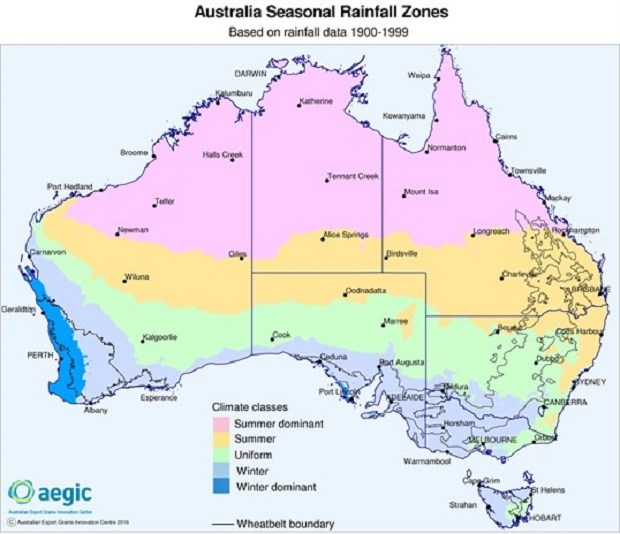New data collected by the Australian Export Grains Innovation Centre (AEGIC) shows Australia’s climate has changed significantly in the past decade which could affect existing farming and pastoral systems.
AEGIC analysed data from more than 8000 Bureau of Meteorology stations around the country and discovered traditional rainfall zones have experienced a dramatic shift since 2000.
According to AEGIC agro-meteorologist Dr David Stephens, changes to Australia’s climate include a general increase in rainfall across Australia and a corresponding decrease in winter rainfall, leading to shifts in rainfall zones extending for hundreds of kilometres.
“Rainfall between May to October over much of the heavily populated regions of southern Australia has decreased 10 to 30 per cent, while summer rain has increased up to 40 per cent in some areas,” he says.
“This change in climate has major implications for farming and pastoral systems as the profitability of different crop type changes, disease risk changes, and the composition of rangeland grasses changes with stocking rates.”
 |
|
Australian rainfall zones from 1900 to 1999..
|
 |
|
As the map above indicates, traditional rainfall zones have shifted significantly in the last 15 years.
|
For example, in pastoral regions in much of Western Australia, increasing summer rain with a reduction in rainfall variability has assisted perennial C4 (tropical) plants at the expense of C3 (temperate) grasses.
In central and northern Queensland, an increase in rainfall variability has been detrimental on pasture production and stocking rates.
“Australia is going to need some of the most water-efficient farming systems in the world to mitigate the effects of a drier and warmer climate in Southern Australia,” Stephens says.
“Research in this area is vital because Australian crop yields have been among the most affected by climate change compared to other grain exporting nations.”
Other major findings of AEGIC’s research include:
- For regions with a Mediterranean climate, winter (and winter dominant) rainfall zones are contracting in a south-westerly direction.
- In northern and eastern areas, summer (and summer dominant) rainfall zones are expanding southward.
- Between these regions, there is a uniform rainfall zone where summer and winter rainfall are similar. The southern boundary of this zone has shifted from southern/central New South Wales down into central Victoria and the Mallee region of south-east South Australia.
- In the south-west of Western Australia, a uniform rainfall zone has appeared along the eastern edge of the wheat-belt from Beacon to Southern Cross to Grass Patch.
- Most rainfall zone boundaries have typically shifted 100-400km over the last 16 years. The only expansion of the winter rainfall zone has occurred in southeast Tasmania where winter rainfall has become more reliable.
Stephens adds farmers who are sowing their winter crops earlier should continue to do so as early sown crops can take advantage of any additional summer soil moisture.
“They also experience a lower evaporative demand through the growing season, and are less affected by declining rain in October and rising spring temperatures,” he says.
Pressure, temperature and wind changes
In addition to the above findings, AEGIC has also collected some climate change information related to shifts in barometric pressure, sea surface temperatures and upper level westerly winds.
These findings include:
- Variability in annual rainfall across Australia has changed since 2000. Reduced variability in some regions is due to the loss of wet years, as in south-west Australia, or more consistent average to above average rain, as in the north-western parts of the country and southern South Australia.
- Variability in annual rainfall has increased in inland Victoria, southern New South Wales and much of central Queensland.
- Sea surface temperatures have warmed in all seasons, which is beneficial for summer rainfall.
- In the mid-1970s, there was a weakening of the Indian Ocean Trough to the west of Perth which appears to be related to a decline in winter rainfall since then. In the 2000s, this trough has weakened further in conjunction with strengthening high pressures over Australia.
- A more marked warming in oceans west of Perth in winter has an inverse relationship to rainfall and has contributed to weaker cloud-band activity in recent years.
- At a Hemispheric scale, one of the drivers of weather is the temperature gradient between the equator and the South Pole. This gradient dropped at the beginning of the 2000s as westerly winds in May-July weakened over Australia.
Stephens presented AEGIC’s climate change findings at the recent 2016 GRDC Perth Grains Research Update held at the Perth Convention Centre earlier this week.


